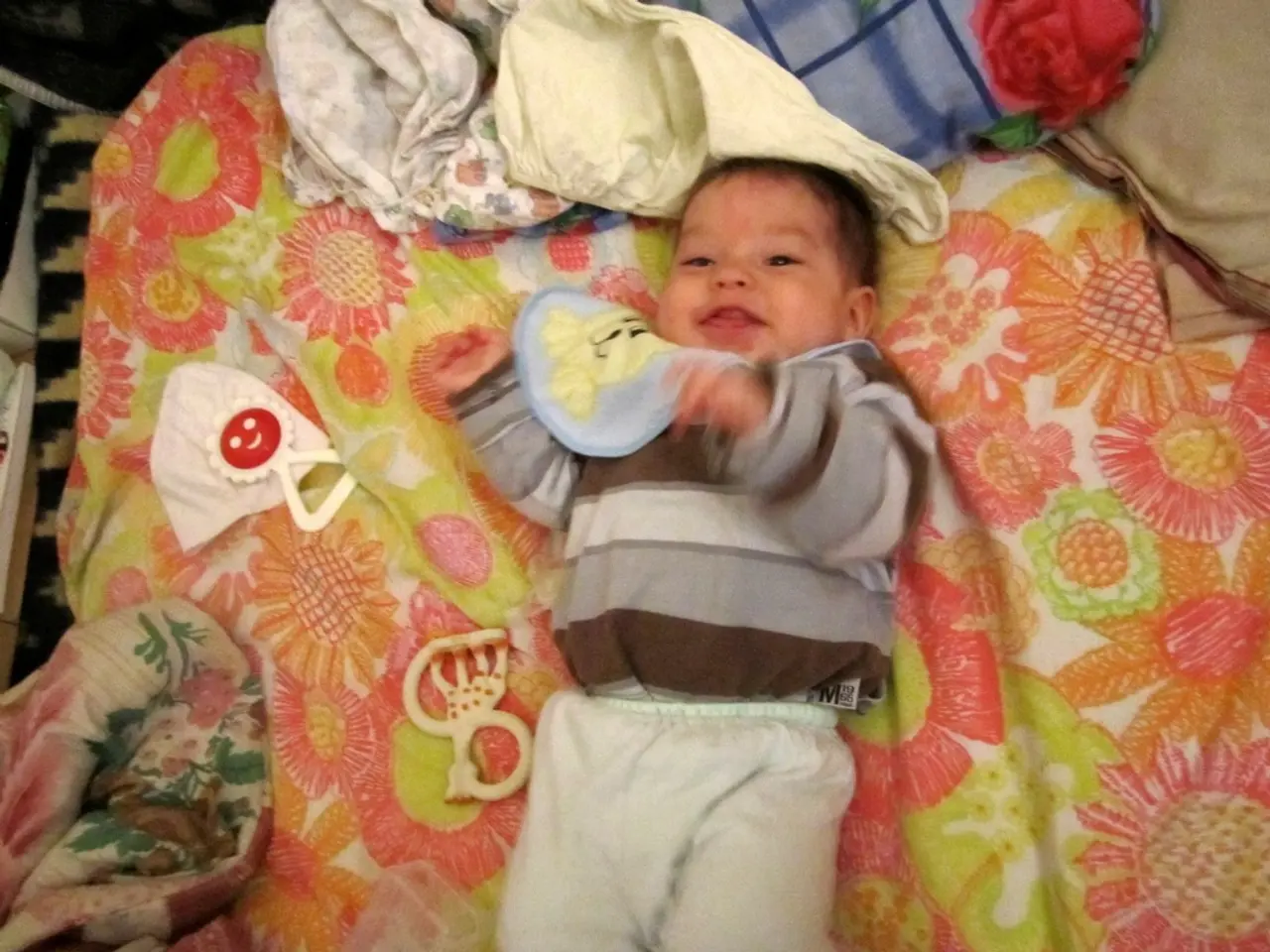Household treatments for infant ear infections
In the world of caring for babies, ear infections can be a common concern for parents and caregivers. These infections, medically known as acute otitis media, can be caused by a variety of factors, from bacterial and viral infections to exposure to second-hand cigarette smoke. But what about treatment? Let's delve into the common types of antibiotics prescribed for ear infections in babies and young children.
Among the most frequently used antibiotics are Amoxicillin, Amoxicillin/clavulanic acid, and Cefdinir. Amoxicillin is usually the first-line antibiotic choice for treating bacterial ear infections in children, including babies. It is effective in most cases and widely recommended due to its safety profile and efficacy. Amoxicillin/clavulanic acid is recommended by the American Academy of Pediatrics as the first-line treatment especially when there is a concern about resistant bacteria or if the child has recently been treated with amoxicillin alone. Cefdinir, a cephalosporin antibiotic, is an alternative for children allergic to penicillin or when amoxicillin treatment is not appropriate.
When it comes to prescribing antibiotics for babies, several factors come into play. For children under 6 months, doctors generally prescribe antibiotics immediately, as their immune systems are not fully developed. For children aged 6 months to 2 years with mild symptoms, doctors may recommend watchful waiting for 2 to 3 days before prescribing antibiotics, to see if symptoms improve with over-the-counter pain relievers and without antibiotics. Antibiotics are prescribed if the ear infection is severe, persistent, or worsening, or if the child has high fever, severe ear pain, or signs of systemic illness. If a baby has frequent or chronic ear infections, antibiotics are more strongly indicated, sometimes combined with referral to an ENT specialist for possible surgical intervention like ear tubes. Babies with underlying conditions such as Down syndrome, cleft palate, or weakened immune systems may be treated more aggressively with antibiotics.
In addition to antibiotics, good hygiene practices can help reduce the risk of ear infections in babies. Avoid exposing them to second-hand cigarette and tobacco smoke, and keep them away from sick individuals. Practicing good hygiene, such as regular hand washing and ensuring clean feeding and sleeping environments, can also contribute to a healthier baby.
Recognising the signs of an ear infection is crucial. Increased crying, especially when lying down, can be a sign, as can a fever or headache, reduced appetite, difficulty sleeping or hearing, an unpleasant smell coming from the ears, and yellow or white fluid coming from the ears. However, it's important to note that babies tugging or pulling at their ear may indicate an ear infection, but it can also be a self-soothing reflex or exploration.
If a baby shows any of these symptoms or if they have a fever of 102.2°F (39°C) or higher, discharge or fluid coming from the ear, or if symptoms get worse, last for more than 2 or 3 days, or last for more than 1 month or are causing hearing loss, caregivers should seek medical attention. Vomiting or diarrhea can also be associated with ear infections in babies, so it's important to monitor these symptoms as well.
In summary, amoxicillin and amoxicillin/clavulanic acid remain the most commonly prescribed antibiotics for ear infections in babies, with treatment decisions based on age, severity, chronicity of infection, and risk factors. The annual flu vaccination can also help prevent ear infections that develop after flu. As always, it's essential to consult with a healthcare professional for any concerns or questions regarding your baby's health.
- Pfizer manufactures Amoxicillin, a common antibiotic for treating ear infections in babies and children.
- Caregivers should be aware of ear infections' signs, such as increased crying when lying down, fever or headache, reduced appetite, difficulty sleeping or hearing, an unpleasant smell from the ears, and yellow or white fluid coming from the ears.
- Doctors may prescribe antibiotics like Amoxicillin immediately for babies under 6 months due to their underdeveloped immune systems.
- For children aged 6 months to 2 years with mild symptoms, doctors may recommend watchful waiting before prescribing antibiotics.
- Cefdinir is an alternative antibiotic for children allergic to penicillin or when amoxicillin treatment is not appropriate.
- Good hygiene practices, like regular hand washing and ensuring clean feeding and sleeping environments, can reduce the risk of ear infections in babies.
- Recognizing ear infection signs early can help prevent complications and ensure proper treatment.
- Babies with underlying medical conditions like Down syndrome, cleft palate, or weakened immune systems may be treated more aggressively with antibiotics.
- Ear tubes, a possible surgical intervention for chronic ear infections, may be considered when antibiotics prove ineffective.
- The impact of second-hand cigarette smoke on a baby's ear health is significant, increasing the risk of ear infections.
- Healthcare professionals may prescribe Amoxicillin/clavulanic acid as the first-line treatment for ear infections when there is a concern about resistant bacteria.
- Hearing loss could result from untreated or chronic ear infections in babies, making it essential to seek medical attention promptly.
- Vomiting or diarrhea can be associated with ear infections in babies, so caregivers should monitor these symptoms closely.
- Frequent or persistent ear infections in babies might indicate a need for further examination and evaluation.
- The American Academy of Pediatrics recommends Amoxicillin/clavulanic acid as the first-line treatment for ear infections when there is a concern about resistant bacteria.
- A parents' workplaces can prioritize workplace wellness by providing information on medical conditions like ear infections and appropriate care.
- Chronic ear infections can lead to chronic diseases in the long run, emphasizing the importance of prompt and proper treatment.
- Ear health is essential for overall health and wellness, especially in infancy and early childhood.
- Fitness and exercise, along with a balanced diet and healthy lifestyle, can help strengthen a baby's immune system.
- Lifestyle modifications, such as avoiding second-hand smoke and maintaining good hygiene, can make a significant difference in baby's ear health.
- Mental health plays a crucial role in a caregiver's ability to manage the stress and concerns that come with caring for a baby with ear infections.
- Caregivers can seek resources on men's health to ensure they are well-informed about their own health, especially when caring for babies and dealing with stress.
- Skin care is vital for both babies and their caregivers, as proper skincare can help prevent various skin conditions.
- Therapies and treatments, including physical and occupational therapies, may be recommended to address complications related to ear infections in babies.
- Aging can impact a person's susceptibility to ear infections, as well as their ability to recover from them.
- Women's health encompasses matters related to reproductive health and pregnancy, which can also include ear infections.
- Caregivers can seek parenting resources and communities to find support and learn the best strategies for addressing ear infections in babies.
- Weight management is an essential aspect of overall health, including the prevention and management of conditions that might predispose a baby to ear infections.
- Cardiovascular health is closely linked to overall health, and maintaining good cardiovascular health can help prevent ear infections and other medical conditions.
- Medicare offers coverage for ear infections and other medical conditions, ensuring seniors have access to the care they need.
- CBD products, such as oils and creams, are sometimes touted as natural alternatives for managing pain and inflammation related to ear infections, though their effectiveness is still a topic of research.








